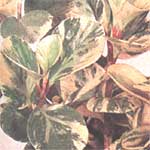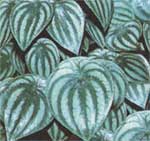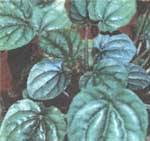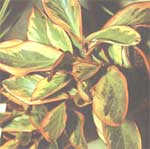Peperomy
Refers to the pepper family. Homeland - South America.
General description: There is an impressive variety of species and forms of pyperomy, they can be large or compact, ampel or bushlike. The peromias grow slowly, the roots are small, they are often used in the compilation of flower compositions. Inflorescence - long, cord-like, with tiny greenish flowers, very similar to inflorescence of plantain. Only some species bloom in indoor conditions.
All the peperomies disinfect the atmosphere from pathogenic bacteria.
The most common ampel epithermies are:
Peperomia scandens (Pomeranian climbing) owns pink stems and cuttings. The leaves are up to 5 cm long, with a waxy surface, a pointed oval shape. The color is green or multicolored, with yellow spots.
Peperomia prostrata (Peperomy creeping). Leaves are small, up to 1 cm long, with silvery or bronze spots. The stalks are scarlet.
Peperomia rotundifolia (Peumerium rotundifolia) leaves appear small, round, sit on a green stalk quite often.
The most common bushlike peperomy:
Peperomia argyreia (Peperomy silvery) is a small plant with a small stalk. Egglike leaves have silvery stripes.
Peperomia caperata (Peperomy shriveled) is a compact bush with small heart-shaped leaves on red cuttings. The surface of the leaves is wrinkled. There is a variegated view with snow-white edges.
The most common upright peperomy:
Peperomia magnoliaefolia possesses round, juicy leaves up to 12 cm long, green or yellow-green, stems fleshy, strongly branching, with a reddish tinge.
Peperomia clusiaefolia (Peperomy clusiformia). The size of the plant is the same as if the previous species. The leaves are back-ovate, bright, fleshy. The dark green leaf paint has a reddish tinge and a purplish border.
Recommendations for caring for the plant Peperomy:
Illumination : Needs bright, but diffused light.
Irrigation regime : Moderate during growth, in winter unusual, by the measure of drying of the soil. He does not adore in any way the overflow, nor the drying out of the earth.
Humidity : Requires regular spraying and wiping of large leaves with a damp soft cloth.
Temperature regime : In summer it is optimal 18-20 ° С, in winter 16-18 ° C, not lower than 14 ° С. Do not like the subcooling of the root system.
Soil : Drainage is mandatory. You can add charcoal and brick chips.
Recommended soil mixture: 1 share leaf, 1 share of peat land and 1 share of sand.
During the growth period, it needs fertilizing once every two weeks with liquid fertilizer for houseplants in half.
Breeding : Peperomy is easily bred by stem cuttings, seeds in the spring. Bush-shaped peperomy is allowed to propagate by leaf cuttings.
Transplantation : Transplanted in the spring, at what time the pot is made tight (the roots begin to germinate through the drainage holes). The root system is superficial, so the pot must be wide, but not deep at all.
Pests : Affected by a spider mite (in a dry atmosphere, leaves and stems are cobwebby), thrips (grayish dots appear on the leaves).
With a slight infection, the plant is allowed to help finish with a soap solution and a warm wash.
In case of severe damage, spraying with an insecticide solution (acticle, decis, phytoverm etc.) is recommended.





Magnoliaceae peperomy - peperomia magnoliaefolia
Peperomy obtusifolia
Peperomy argyreia
Gray-silver peperomy - peperomia griseoargentea
Peperomia clusiaefolia
Peperomia pereskiaefolia


Comments
When commenting on, remember that the content and tone of your message can hurt the feelings of real people, show respect and tolerance to your interlocutors even if you do not share their opinion, your behavior in the conditions of freedom of expression and anonymity provided by the Internet, changes Not only virtual, but also the real world. All comments are hidden from the index, spam is controlled.